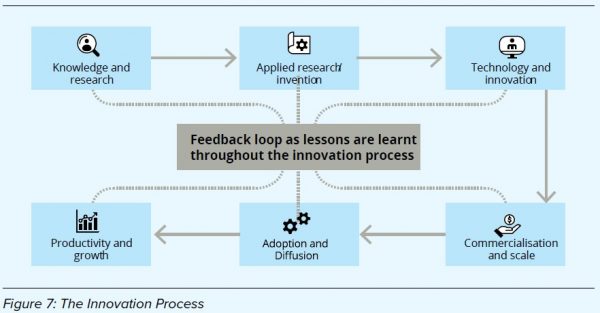09 May Optimising the start-up ecosystem
Challenge
To optimise across Australia the key and complex elements that together will ensure a thriving and self-sustainable space and spatial start-up ecosystem capable of organic growth.
OPPORTUNITY FOR GROWTH
An agile, risk-loving and ground-breaking private sector is what drives the productivity and innovation that creates economic growth.
The process of developing, testing and scaling innovation to support a trajectory of sustainable and productive economic growth cannot be undertaken by a start-up in isolation. It requires the support of a wide range of actors across the value chain and start-up ecosystem. It is the dynamic interactions and collaboration between innovation stakeholders that underpins the constant feedback within start-up ecosystems that drives innovation to fuel the long-term cycle of productivity gains and the creation of high-value adding employment.
In the long run, the process of innovation relies on the flow of new scientific ideas, inventions and innovations. Experimentation, research and development activities are a small proportion of the broader information/knowledge economy, but they are at the heart of the complex process of innovation:

The key enablers that create value in the start-up ecosystem include research institutions, disruptive technology, entrepreneurs, investors, government, regulation, capital, skilled labour, land and existing companies.
At a seminar run by LaunchVic in June 2020 number of successful start-up entrepreneurs noted that what they were particularly looking for, in addition to capital and markets, in their local
start-up ecosystem included; a cluster of start-ups in the same precinct not necessarily from the same industry, light touch accommodation arrangements that permitted scale up or down readily with little red-tape, and ready access to public transport for ease of movement.
These key questions need to be answered for the space and spatial industries:
- How can we grow the funnel of the start-ups per million people in Australia?
- How can we increase the start-up success rate?
- How can we maximise the economic value-add to Australia?
- What impediments do we need to identify and address?
- How do we prioritise areas of innovation for start-ups to maximise chance of success?
- How to encourage ‘fail-fast’ as a learning process?
- How to create more training opportunities for entrepreneurs (knowing that the people involved are a major factor in success and what VC’s look at)?
- How to use programs like Moon-to-Mars to support start-ups with good ideas (do we try to pick winners?)?
There are a number of known impediments to the start-up ecosystem. These include; access to ready capital, availability of suitably skilled people, and a national cultural mindset that is too tentative when it comes to risk taking and too dismissive of the hard-won experience of repeated failure.
ACTIONS
1. Poll selected members of the ecosystem for their advice against the four questions raised above. Suggested organisations for polling include: AURORA (SmartSat CRC’s formal ecosystem of around 40 start-ups), SIAA members and SIBA-GITA (successful companies have an enormous store of knowledge about their start-up period), and SIAA members (who collectively span many of the key elements of the spatial ecosystem, and probably the space ecosystem as well). This advice can then be assembled and an action plan developed.


